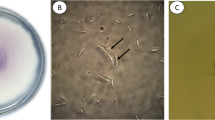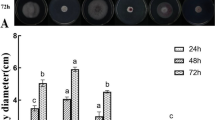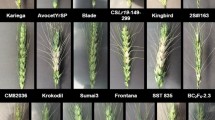Abstract
Fusarium graminearum and F. culmorum are phytopathogenic species that cause head blight and crown rot diseases in cereals worldwide. These two phytopathogenic fungi show great variation in terms of phenotypic, biochemical and genetic characteristics. In this study, linear growth rate, thiophanate methyl (TPM) resistance, survival and toxin production- associated gene expressions, and beta-tubulin nucleotide sequence knowledge of F. graminearum from Turkey and Iran and F. culmorum isolates from Turkey were investigated. The mean linear growth rate values of isolates ranged from 7.58 to 15.16 mm/day. In TPM resistance analysis, each isolate was characterized as highly sensitive to TPM, with IC50 values between 2 and 4 μg/ml TPM. TPM-subjected isolates showed decreased tri5 gene expression and increased Mgv and StuA expression. Amino acid conservations at codons 198 and 200 in the beta tubulin gene were also investigated in order to confirm TPM resistance and reveal genetic diversity in Fusarium species. Each isolate showed conserved amino acids at 198 and 200 codons, resulting in sensitive genotypes. The bootstrap support value for genetic similarity was more than 70%. Findings obtained from this study showed that Fusarium isolates that cause head blight and crown rot in Turkey have a low level of variation in terms of phenotype and genetic characteristics. Moreover, this is the first report to show that TPM led to a potential decrease in toxin production-associated genes and increased potential of sexual/asexual reproduction genes. Results could provide improved and comprehensive data for the struggle against Fusarium pathogens.



Similar content being viewed by others
References
Albayrak G, Yörük E, Gazdagli A (2016) Genetic diversity among Fusarium graminearum and F. culmorum isolates based on ISSR markers. Arch Biol Sci 68:333–343
Anand A, Zhou T, Trick HN, Gill BS, Bockus WW, Muthukrishnanl S (2003) Greenhouse and field testing of transgenic wheat plants stably expressing genes for thaumatin-like protein, chitinase and glucanase against Fusarium graminearum. J Exp Biol 54:1101–1111
Arif T, Bhosale JD, Kumar N, Mandal TK, Bendre RS, Lavekar GS, Dabur R (2009) Natural products-antifungal agents derived from plants. J Asian Nat Prod Res 11:621–638
Arslan Ü, Baykal N (2002) Reactions of some wheat cultivars against root and crown rot fungal pathogens and efficacy of seed protectant fungicides to fusarium culmorum (W.G.Sm.) Sacc. J Agric Fac Uludag Univ 16:69–76
Bai G, Shaner G (1996) Variation in Fusarium graminearum and cultivar resistance to wheat scab. Plant Dis 80:975–979
Bai G, Shaner G (2004) Management and resistance in wheat and barley to fusarium head blight. Annu Rev Phytopathol 42:135–161
Bernardo A, Bai G, Guo P, Xiao K, Guenzi AC, Ayoubi P (2007) Fusarium graminearum-induced changes in gene expression between fusarium head blight-resistant and susceptible wheat cultivar. Funct Integr Genomic 7:69–77
Brandfass C, Karlovsky P (2006) Simultaneous detection of Fusarium culmorum and Fusarium graminearum in plant material by duplex PCR with melting curve analysis. BMC Microbiol 6:1–10
Burgess LW, Summerrell BA, Bullock S, Gott KP, Backhouse D, (1994) Laboratory Manual for Fusarium Research, 3rd edn. University of Sydney Press, Sydney
Chung WH, Ishii H, Nishimura K, Ohshima M, Iwama T, Yoshimatsu H (2008) Genetic analysis and PCR-based identification of major Fusarium species causing head blight on wheat in Japan. J Gen Plant Pathol 10:110–118
Creppy EE (2002) Update of survey, regulation and toxic effects of mycotoxins in Europe. Toxicol Lett 127:19–28
Cuomo CA et al (2007) The Fusarium graminearum genome reveals a link between localized polymorphism and pathogen specialization. Science 317:1400–1402
Çepni E, Gürel F, Tunali B (2013) Genetic diversity and mating types of Fusarium culmorum and Fusarium graminearum isolates in Turkish crop breeding areas. J Basic Microbiol 52:1–9
Goswami RS, Kistler HC (2004) Heading for disaster: Fusarium graminearum on cereal crop. Mol Plant Pathol 5:515–525
Haratian M, Sharifnabi B, Alizadeh A, Safaie N (2008) PCR analysis of the tri13 gene to determine the genetic potential of Fusarium graminearum isolates from Iran to produce nivalenol and deoxynivalenol. Mycopathologia 166:109–116
Hou Z, Xue C, Peng Y, Katan T, Kistler HC, Xu J (2002) A mitogen-activated protein kinase gene (MGV1) in Fusarium graminearum is required for female fertility heterokaryon formation, and plant infection. Mol Plant-Microbe Interact (11):1119–1127
Irzykowska L, Weber Z, Bocianowski J (2012) Comparison of Claviceps purpurea populations originated from experimental plots or fields of rye. Cent Eur J Biol 7:839–849
Iwama T, Katsube K, Ishii H (2007) Detection of thiophanate-methyl resistant isolates of Fusarium culmorum, a causal agent of fusarium head blight on wheat, in Aomori prefecture, northern Japan. Jpn J Phytopathol 73:162–165
Kang Z, Huang L, Krieg U, Machnik MA, Buchenauer H (2001) Effects of tebuconazole on morphology, structure, cell wall components and trichothecene production of Fusarium culmorum in vitro. Pest Manag Sci 57:491–500
Karababa M, Coste AL, Rognon B, Bille J, Sanglard D (2004) Comparison of gene expression profiles of Candida albicans azole-resistant clinical isolates and laboratory strains exposed to drug inducing multidrug transporters. Antimicrob Agents Chemother 48:3064–3079
Kerényi Z, Moretti A, Waalwijk C, Olah B, Hornok L (2004) Mating type sequences in asexually reproducing Fusarium species. Appl Environ Microbiol 70:4419–4423
Kelly A, Proctor RH, Belzile F, Chulze SN, Clear RM, Cowger C, Elmer W, Lee T, Obanor F, Waalwijk C, Ward TJ (2016) The geographic distribution and complex evolutionary history of the NX-2 trichothecene chemotype from Fusarium graminearum. Fungal Genet Biol 95:39–48
Konstantinova P, Yli-Mattila T (2004) IGS-RFLP analysis and development of molecular markers for identification of F. poae, F. pulverosum, F. sporotrichioides and F. kyushuemse. Int J Food Microbiol 95:321–331
Lee T, Oh DW, Kim HS, Lee J, Kim YH, Yun SH, Lee YW (2001) Identification of deoxynivalenol-and nivalenol-producing chemotypes of Gibberella zeae by using PCR. Appl Environ Microbiol 67:2966–2972
Leroux P, Fritz R, Debieu D, Albertini C, Lanen C, Bach J, Gredt M, Chapeland F (2002) Mechanisms of resistance to fungicides in field strains of Botrytis cinerea. Pest Manag Sci 58:876–888
Livak JK, Schmittgen TD (2001) Analysis of relative gene expression data using real time quantitative PCR and the 2-ΔΔCT method. Methods 25:402–408
Matny ON (2015) Fusarium head blight and crown rot on wheat and barley: losses and health risks. Adv Plants Agr Res 2:1–6
Miedaner T, Schilling AG, Geiger HH (2001) Molecular genetic diversity and variation for aggressiveness in populations of Fusarium graminearum and Fusarium culmorum sampled from wheat fields in different countries. J Phytopathol 149:641–648
Miedaner T, Cumagun CJR, Chakraborty S (2008) Population genetics of three important head blight pathogens Fusarium graminearum, F. pseudograminearum and F. culmorum. J Phytopathol 156:129–139
Nelson PE, Dignani MC, Anaissie EJ (1994) Taxonomy, biology, and clinical aspects of Fusarium species. Clin Microbiol Rev 7:479–504
Nicholson P, Simpson DR, Weston G, Rezanoor HN, Lees AK (1998) Detection and quantification of Fusarium culmorum and Fusarium graminearum in cereals using PCR assays. Physiol Mol Plant Pathol 53:17–37
Niu C, Kebede H, Auld DL, Woodward JE, Burow G, Wright RJ (2008) A safe inexpensive method to isolate high quality plant and fungal DNA in an open laboratory environment. Afr J Biotechnol 7:2818–2822
Obanor F, Erginbas-Orakci G, Tunali B, Nicol JM, Chakraborty S (2010) Fusarium culmorum is a single phylogenetic species based on multilocus sequence analysis. Fungal Biol 114:753–765
O’Donnell K, Kistler HC, Tacke BK, Casper HH (2000) Gene genealogies reveal global phylogeographic structure and reproductive isolate on among lineages of Fusarium graminearum, the fungus causing wheat scab. P Natl Acad Sci USA 97:7905–7910
Pasquali M, Spanu F, Scherm B, Balmas V, Hoffmann L, Beyer M, Migheli Q (2013) FcStuA from Fusarium culmorum controls wheat foot and root rot in a toxin dispensable manner. PLoS One 8:e57429
Pasquali M, Migheli Q (2014) Genetic approaches to chemotype determination in type B-trichothecene producing Fusaria. Int J Food Microbiol 189:164–182
Pasquali M et al (2016) A European database of Fusarium graminearum and F. culmorum Trichothecene genotypes. Front Microbiol 7:406
Przemieniecki SW, Kurowski TP, Korzekwa K (2014) Chemotypes and geographic distribution of the Fusarium graminearum species complex. Environ Biotechnol 10:45–54
Sanglard D, Coste A, Ferrari S (2009) Antifungal drug resistance mechanisms in fungal pathogens from the perspective of transcriptional gene regulation. FEMS Yeast Res 9:1029–1050
Scherm B, Orru M, Balmas V, Spanu F, Azara E, Delogu G, Hammond TM, Keller NP, Migheli Q (2011) Altered trichothecene biosynthesis in TRI6-silenced transformants of Fusarium culmorum influences the severity of crown and foot rot on durum wheat seedlings. Mol Plant Pathol 12:759–771
Scherm B, Balmas V, Spanu F, Pani G, Delogu G, Pasquali G, Migheli Q (2013) Fusarium culmorum: causal agent of foot and root rot and head blight on wheat. Mol Plant Pathol 14:323–341
Suga H, Nakajima T, Kageyama K, Hyakumachi M (2011) The genetic profile and molecular diagnosis of thiophanate-methyl resistant strains of Fusarium asiaticum in Japan. Fungal Biol 115:1244–1250
Tamura K, Stecher G, Peterson D, Filipski A, Kumar S (2013) MEGA6: molecular evolutionary genetics analysis version 6.0. Mol Biol Evol 30:2725–2729
Vandeputte P, Ferrari S, Coste AT (2012) Antifungal resistance and new strategies to control fungal infections. Int J Microbiol. https://doi.org/10.1155/2012/713687
Varga E, Wiesenberger G, Hametner C, Ward TJ, Dong YH, Schofbeck D et al (2015) New tricks of an old enemy: isolates of Fusarium graminearum produce a type a trichothecene mycotoxin. Environ Microbiol 17:2588–2600
Waalwijk C, van der Heide R, de Vries I, Van der Lee T, Schoen C, Costrel-de Corainville G, Häuser-Hahn I, Kastelein P, Köhl J, Lonnet P, Demarquet T, Kema GHJ (2004) Quantitative detection of Fusarium species in wheat using TaqMan. Eur J Plant Pathol 110:481–494
Wang JH, Li HP, Qu B, Zhang JB, Huang T, Chen FF, Liao YC (2008) Development of a generic PCR detection of 3-acetyldeoxy-nivalenol-, 15-acetyldeoxynivalenol- and nivalenol-chemotypes of Fusarium graminearum clade. Int J Mol Sci 9:2495–2504
Ward TD, Clear RM, Rooney AP, O’Donnell K, Gaba D, Patrick S et al (2008) An adaptive evolutionary shift in Fusarium head blight pathogen populations is driving the rapid spread of more toxigenic Fusarium graminearum in North America. Fungal Genet Biol 45:473–484
Windels CR (2000) Economic and social impacts of Fusarium head blight: changing farms and rural communities in the northern Great Plains. Phytopathol 90:17–21
Yarden O, Katan T (1993) Mutations leading to substitutions at amino acids 198 and 200 of beta-tubulin that correlate with benomyl-resistance phenotypes of field strains of Botrytis cinerea. Phytopathol 83:1478–1483
Yli-Mattila T, Gagkaeva T (2010) Molecular chemotyping of Fusarium graminearum, F. culmorum and F. cerealis isolates from Finland and Russia. In: Gherbawy Y, Voigt K (eds) Molecular identification of fungi. Springer Verlag, Berlin, pp 159–177
Yli-Mattila T, Gagkaeva T, Ward TJ, Aoki T, Kistler HC, O'Donnell K (2009) A novel Asian clade within the Fusarium graminearum species complex includes a newly discovered cereal head blight pathogen from the Russian far east. Mycologia 101:841–852
Yli-Mattila T, Rämö S, Hietaniemi V, Hussien T, Carlobos-Lopez AL, Cumagun CJR (2013) Molecular quantification and genetic diversity of toxigenic Fusarium species in northern Europe as compared to those in southern Europe. Microorganisms 1:162–174
Yörük E, Tunali B, Kansu B, Ölmez F, Uz G, Zümrüt IM, Sarıkaya A, Meyva G (2016) Characterization of high-level deoxynivalenol producer Fusarium graminearum and F. culmorum isolates caused head blight and crown rot diseases in Turkey. J Plant Dis Prot 123:177–186
Acknowledgements
This study was supported by the Board of Regents of Istanbul Yeni Yüzyıl University and TÜBİTAK 109O476 and 111O835 numbered projects. Fungal material was obtained from TÜBİTAK projects numbered 109O476 and 111O835. Dr. Emre Yörük is the main author of the article.
Author information
Authors and Affiliations
Corresponding author
Rights and permissions
About this article
Cite this article
Yörük, E., Sefer, Ö., Tunali, B. et al. Thiophanate methyl susceptibility and alterations in tri5, Mgv1 and StuA expression among Fusarium graminearum and F. culmorum isolates. J Plant Pathol 100, 447–455 (2018). https://doi.org/10.1007/s42161-018-0094-y
Published:
Issue Date:
DOI: https://doi.org/10.1007/s42161-018-0094-y




